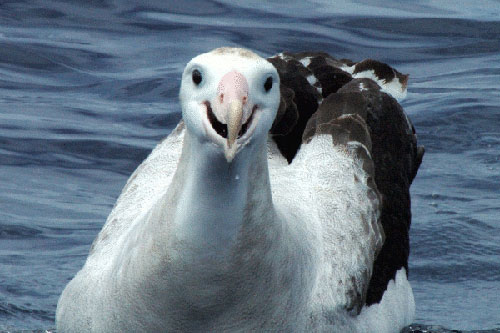John Croxall (BirdLife International, Cambridge, UK) and colleagues have reviewed the current conservation status of the World's seabirds in the journal Bird Conservation International.
The albatross family is especially imperilled with 17 of the 22 species currently threatened with extinction at the levels of Vulnerable, Endangered or Critically Endangered. Of the 29 species currently listed within the Albatross and Petrel Agreement all but two (the giant petrels Macronectes spp. categorized as Least Concern) have a globally threatened or Near-Threatened status.
"Seabirds are a diverse group of worldwide distribution and as top predators they also provide a valuable indicator of wider marine health", said Professor John Croxall, Chair of BirdLife's Global Seabird Programme, and the paper's lead author (click here).
 Albatross. Antipodean Albatross. Photograph by Mike Double
Albatross. Antipodean Albatross. Photograph by Mike Double
The paper's summary follows:
"We review the conservation status of, and threats to, all 346 species of seabirds, based on BirdLife International's data and assessments for the 2010 IUCN Red List. We show that overall, seabirds are more threatened than other comparable groups of birds and that their status has deteriorated faster over recent decades. The principal current threats at sea are posed by commercial fisheries (through competition and mortality on fishing gear) and pollution, whereas on land, alien invasive predators, habitat degradation and human disturbance are the main threats. Direct exploitation remains a problem for some species bothat sea and ashore. The priority actions needed involve: a) formal and effective site protection, especially for Important Bird Area (IBA) breeding sites and for marine IBA feeding and aggregation sites, as part of national, regional and global networks of Marine Protected Areas; b) removal of invasive, especially predatory, alien species (a list of priority sites is provided), as part of habitat and species recovery initiatives; and c) reduction of bycatch to negligible levels, as part of comprehensive implementation of ecosystem approaches to fisheries. The main knowledge gaps and research priorities relate to the three topics above but new work is needed on impacts of aquaculture, energy generation operations and climate change (especially effects on the distribution of prey species and rise in sea level). We summarise the relevant national and international jurisdictional responsibilities, especially in relation to endemic and globally threatened species."
Click here for more information on the threats seabirds face.
Reference:
Croxall, J.P., Butchart, S.H.M., Lascelles, B., Stattersfield, A.J., Sullivan, B., Symes, A. & Taylor, P. 2012. Seabird conservation status, threats and priority actions: a global assessment. Bird Conservation International 22: 1-34.
John Cooper, ACAP Information Officer, 10 March 2012

 English
English  Français
Français  Español
Español